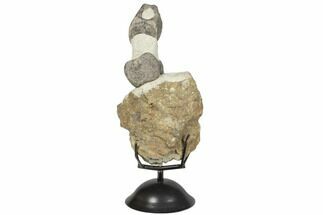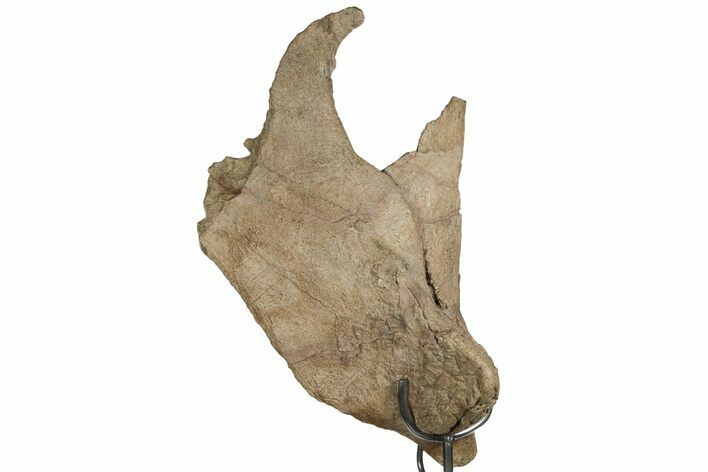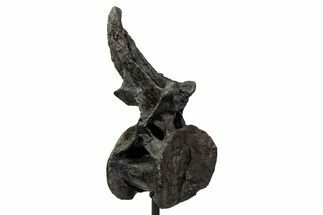This Specimen has been sold.
Impressive, 17.5" Fossil Triceratops Jugal Bone - Montana
This is a massive, 17.5" wide jugal bone of a large adult Triceratops. It was collected from the Hell Creek Formation in Eastern Montana. This incredible specimen is in excellent condition with a beautifully preserved epijugal (armored cheek bone) and a partial orbital just superior to this. The bone preservation is phenomenal, showing some cortical bone and well defined "blood grooves".
On its custom metal stand, this is a very striking display. The wide base and structure of the stand accommodates for the overhanging display of the bone and is very stable.
Measurements:
Entire jugal - 17.5 x 9.7 x 5.7"
Epijugal - approximately 6.3 x 3"
Height on stand - 19.6" tall
There are spots of gap fill restoration where the bone was found disarticulated within the rock. That being said, there are relatively few spots of repair, and gap fill restoration is fairly minimal. Most of the restoration can be seen superior to the epijugal along a repaired crack that runs across the entire bone.
On its custom metal stand, this is a very striking display. The wide base and structure of the stand accommodates for the overhanging display of the bone and is very stable.
Measurements:
Entire jugal - 17.5 x 9.7 x 5.7"
Epijugal - approximately 6.3 x 3"
Height on stand - 19.6" tall
There are spots of gap fill restoration where the bone was found disarticulated within the rock. That being said, there are relatively few spots of repair, and gap fill restoration is fairly minimal. Most of the restoration can be seen superior to the epijugal along a repaired crack that runs across the entire bone.
About Triceratops
Triceratops is one of the most recognized and intriguing of the North American ceratopsid dinosaurs. They stomped around the Late Cretaceous (around 68-66 mya), brandishing their three-pronged and bony frilled skulls, chewing on fibrous plants. They struggled against large predators, stood their ground, and tried not to be devoured by the ferocious Tyrannosaurus rex.
The head on a Triceratops may have been an intimidating show rather than a stabbing, defensive trident and imposing shield for inter-species jousting. Researchers have given close scrutiny to the holes, or fenestrae, of other ceratopsid crests. In the past, the holes within the shield were used to confirm separate species.
Individual Triceratops are estimated to have reached up to 9 meters (29.5 feet) in length, 3 meters (9.8 feet) in height, and weighed up to 26,000 pounds. The largest known skull is estimated to have been 2.5 meters (8.2 feet) long and would have extended almost a third of the length of the mature individual. The pointed horns were approximately 1 meter (3 feet) long. With its sturdy build and powerful legs, Triceratops could have ripped open the predator that wanted this herbivore for dinner.
One of the most abundant of the large Cretaceous fauna, Triceratops plucked low growth with its beak-tipped jaws. Triceratops teeth were arranged in groups, called batteries, of 36 to 40 tooth columns, in each side of each jaw. Each column contained about 3 to 5 stacked teeth, depending on the individual’s size. This produced a range of 432 to 800 teeth, of which only a fraction were in use at any given time (due to tooth replacement). The great size and quantity of teeth suggests that they ate large volumes of fibrous plants. These were possibly palms, cycads, and ferns.
Triceratops was designated as the state fossil of South Dakota in 1988.
Triceratops is one of the most recognized and intriguing of the North American ceratopsid dinosaurs. They stomped around the Late Cretaceous (around 68-66 mya), brandishing their three-pronged and bony frilled skulls, chewing on fibrous plants. They struggled against large predators, stood their ground, and tried not to be devoured by the ferocious Tyrannosaurus rex.
The head on a Triceratops may have been an intimidating show rather than a stabbing, defensive trident and imposing shield for inter-species jousting. Researchers have given close scrutiny to the holes, or fenestrae, of other ceratopsid crests. In the past, the holes within the shield were used to confirm separate species.
Individual Triceratops are estimated to have reached up to 9 meters (29.5 feet) in length, 3 meters (9.8 feet) in height, and weighed up to 26,000 pounds. The largest known skull is estimated to have been 2.5 meters (8.2 feet) long and would have extended almost a third of the length of the mature individual. The pointed horns were approximately 1 meter (3 feet) long. With its sturdy build and powerful legs, Triceratops could have ripped open the predator that wanted this herbivore for dinner.
One of the most abundant of the large Cretaceous fauna, Triceratops plucked low growth with its beak-tipped jaws. Triceratops teeth were arranged in groups, called batteries, of 36 to 40 tooth columns, in each side of each jaw. Each column contained about 3 to 5 stacked teeth, depending on the individual’s size. This produced a range of 432 to 800 teeth, of which only a fraction were in use at any given time (due to tooth replacement). The great size and quantity of teeth suggests that they ate large volumes of fibrous plants. These were possibly palms, cycads, and ferns.
Triceratops was designated as the state fossil of South Dakota in 1988.
The Hell Creek Formation
Renowned for both its age and rich sedimentary layers, the Hell Creek Formation is one of the most intensively studied fossil-bearing regions on Earth. To date, scientists have documented 158 genera of animals and 64 genera of plants from its rocks, with new finds emerging regularly. Beyond iconic dinosaurs such as tyrannosaurs, ceratopsians, and hadrosaurs, the formation has produced an extraordinary array of life, including amphibians, reptiles, lizards, snakes, turtles, fish, sharks, birds, and early mammals. Together, these fossils provide the most complete picture of the ecosystems that thrived just before the Cretaceous–Paleogene extinction event.
Renowned for both its age and rich sedimentary layers, the Hell Creek Formation is one of the most intensively studied fossil-bearing regions on Earth. To date, scientists have documented 158 genera of animals and 64 genera of plants from its rocks, with new finds emerging regularly. Beyond iconic dinosaurs such as tyrannosaurs, ceratopsians, and hadrosaurs, the formation has produced an extraordinary array of life, including amphibians, reptiles, lizards, snakes, turtles, fish, sharks, birds, and early mammals. Together, these fossils provide the most complete picture of the ecosystems that thrived just before the Cretaceous–Paleogene extinction event.
SPECIES
triceratops horridus
LOCATION
Eastern Montana
FORMATION
Hell Creek Formation
SIZE
17.5 x 9.7 x 5.7"
CATEGORY
SUB CATEGORY
ITEM
#198927
We guarantee the authenticity of all of our specimens.
 Reviews
Reviews





















